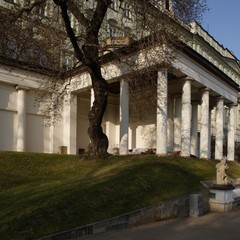The South Gardens
The South Gardens were established gradually on the location of bulwarks beneath Prague Castle. The last renovation in 2012 restored their original appearance from 1920's when they were renovated by the Slovenian architekt Josip Plečnik for the first Czechoslovak president T. G. Masaryk.

The South Gardens are nearly 500 metres long and in the summer tourist season it is possible to enter them from Opyš near the eastern gate or via the Bull Staircase from the Third Courtyard. The west gate between Hradčany Square (Hradčanské náměstí) and the South Gardens is for exit only. The South Gardens are comprised of three smaller gardens.
Paradise Garden
The garden is situated on the spot of the oldest garden in front of the southern wall of the Castle, where a private garden of Archduke Ferdinand used to be in the fifties of the 16th century. Similarly, the emperor Rudolf II also had his private garden here with a bath or for example an aviary. Architect Plečnik designed its current image in 1920's. A monumetal straircase and a big granite bowl became its dominants. On one site the stone border even changes course to bypass probably one of the oldest trees at Prague Castle - a yew tree with the estimated age of about 400 years.
Garden on the Ramparts
The name of the garden refers to an old rampart on the southern side of the Castle where later small gardens were founded to be turned into a natural park in the 19th century. In 1849, a fortification wall was built around the area and can still be seen there, although it has been lowered in 1920's during the renovations of Josip Plečnik. The garden has a unified geometric appearance and it runs beneath most of the southern face wall of Prague Castle. Its central terrace offers a breathtaking view of Prague. At the end of the gardens there is the so called Moravian Bastion, a secluded place where T. G. Masaryk liked to sit.
Hartig Garden
The Hartig Garden with a Music Pavilion is the smallest of the gardens on the southern side of the Castle and it was connected to them in 1960's. Its current image hails back to 1965 to the design by architects Adolf Bens and Richard Podzemny. The garden is closed for public.





